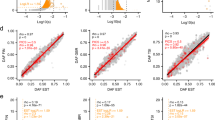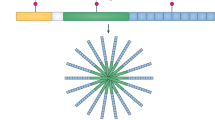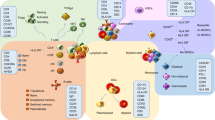Abstract
Mice obtained by bidirectional selective breeding for high (HIII) or low (LIII) antibody (Ab) production are resistant or extremely susceptible to pristane-induced arthritis (PIA), respectively. Several quantitative trait loci regulating Ab production (Ab QTL) have been mapped in these lines, which were used to investigate the influence of these Ab QTL in PIA. Parental HIII and LIII mice and their F1 and F2 intercrosses were injected twice with pristane, and arthritis was observed for 200 days. In LIII mice PIA was more severe and incidence was 100% at day 105, while F1 and F2 mice showed intermediate values. HIII mice were totally resistant. Microsatellite polymorphisms of Ab QTL were analysed and D3Mit100 alleles cosegregated significantly with PIA incidence, severity and onset in F2 intercross mice, while the other four markers showed suggestive values. Results indicate colocalization of QTL for Ab production and PIA susceptibility. Moreover, the different cytokine and IgG isotype profiles observed in HIII and LIII lines after PIA induction are useful to candidate genes endowed with the regulation of the Ab production and arthritis phenotypes.
This is a preview of subscription content, access via your institution
Access options
Subscribe to this journal
Receive 6 digital issues and online access to articles
$119.00 per year
only $19.83 per issue
Buy this article
- Purchase on Springer Link
- Instant access to full article PDF
Prices may be subject to local taxes which are calculated during checkout



Similar content being viewed by others
References
Cooper GS, Stroehla BC . The epidemiology of autoimmune diseases. Autoimmun Rev 2003; 2: 119–125.
Jawaheer D, Thomson W, MacGregor AJ, Carthy D, Davidson J, Dyer PA et al. Homozygosity for the HLA-Dr shared epitope contributes the highest risk for rheumatoid arthritis concordance in identical twins. Arthritis Rheum 1994; 37: 681–686.
John S, Marlow A, Hajeer A, Ollier WE, Silman AJ, Worthington J . Linkage and association studies of the natural resistance associated macrophage protein-1 (Nramp1) locus in rheumatoid arthritis. J Rheumatol 1997; 24: 452–457.
Potter M, Wax JS . Genetics of susceptibility to pristane-induced plasmocytomas in Balb/cJ with a brief description of pristane-induced arthritis. J Immunol 1981; 127: 1591–1595.
Stasiuk L, Ghoraisian M, Elson CJ, Thompson SJ . Pristane-induced arthritis is CD4+ T-cell dependent. Immunology 1997; 90: 81–86.
Thompson SJ, Elson CJ . Susceptibility to pristane-induced arthritis is altered with changes in bowel flora. Immunol Lett 1993; 36: 227–232.
Thompson SJ, Rook GA, Breakley RJ, Van der Zee R, Elson CJ . Autoimmune reactions to heat-shock proteins in pristane-induced arthritis. Eur J Immunol 1990; 20: 2479–2484.
Biozzi G, Mouton D, Sant'Anna OA, Passos HC, Gennari M, Reis MH et al. Genetics of immunoresponsiveness to natural antigens in the mouse. Curr Top Microbiol Immunol 1979; 85: 31–98.
Siqueira M, Bandieri A, Reis MH, Sant'Anna OA, Biozzi G . Selective breeding of mice for antibody responsiveness to flagellar and somatic antigens of Salmonellae. Eur J Immunol 1976; 6: 241–249.
Mouton D, Stiffel C, Biozzi G . Genetic factors of immunity against infection. Ann Inst Pasteur Immunol 1985; 136D: 131–141.
Sant'Anna OA, Massa S, Mouton D, Bouthillier Y, Mevel JC, Ibañez OM et al. Salmonella Typhimurium infection in high and low antibody responder mice: inverse correlation between antibody responsiveness and resistance to infection. FEMS Microbiol Immunol 1989; 47: 465–472.
De Franco M, Gille-Perramant MF, Mevel JC, Couderc J . T helper subset involvement in two high antibody responder lines of mice (Biozzi mice): HI (susceptible) and HII (resistant) to collagen-induced arthritis. Eur J Immunol 1995; 25: 132–136.
Covelli V, Mouton D, Di Majo V, Bouthillier Y, Bangrazi C, Mevel JC et al. Inheritance of immune responsiveness, life span, and disease incidence in interline crosses of mice selected for high or low multispecific antibody production. J Immunol 1989; 142: 1224–1234.
Ibañez OM, Mouton D, Ribeiro OG, Bouthillier Y, De Franco M, Cabrera W et al. Low antibody responsiveness is found to be associated with resistance to chemical skin tumorigenesis in several lines of Biozzi mice. Cancer Lett 1999; 136: 153–158.
Sant'Anna OA, Bouthillier Y, Mevel JC, De Franco M, Mouton D . Isotypic distribution of antibody responses in lines of mice selected for high or low immunoresponsiveness. Braz J Med Biol Res 1991; 24: 407–416.
Sant'Anna AO, Ferreira VC, Reis MH, Gennari M, Ibañez OM, Esteves MB et al. Genetic parameters of the polygenic regulation of antibody responsiveness to flagellar and somatic antigens of Salmonellae. J Immunogenet 1982; 9: 191–205.
Reis M, Ibañez OM, Cabrera WH, Ribeiro OG, Mouton D, Siqueira M et al. T-helper functions in mice selected for high and low antibody production (Selection III): modulation by anti-CD4+ monoclonal antibody. Immunology 1992; 75: 80–85.
de Souza CM, Morel L, Cabrera WHK, Starobinas N, Ribeiro OG, Siqueira M et al. Quantitative trait loci in chromosomes 3, 8 and 9 regulate antibody production against Salmonella flagellar antigens in the mouse. Mamm Genome 2004; 15: 630–636.
Frangoulis B, Mouton D, Sant'Anna OA, Vidard L, Pla M . H-2 typing of mice genetically selected for high and low antibody production. Immunogenetics 1990; 31: 389–392.
Roger T, Boudaly S, Seman M . Negative segregation of Mtv loci in H-2E+ mice selected for high antibody response. Immunogenetics 1994; 40: 123–128.
Jirholt J, Cook A, Emahazion T, Sundvall M, Jansson L, Nordquist N et al. Genetic linkage analysis of collagen-induced arthritis in the mouse. Eur J Immunol 1998; 28: 3321–3328.
Adarichev VA, Nesterovitch AB, Bardos T, Biesczat D, Chandrasekaran R, Vermes C et al. Sex effect on clinical and immunologic quantitative trait loci in a murine model of rheumatoid arthritis. Arthritis Rheum 2003; 48: 1708–1720.
Johannesson M, Karlsson J, Wernhoff P, Nandakumar KS, Lindqvist AK, Olsson L et al. Identification of epistasis through a partial advanced intercross reveals three arthritis loci within the Cia5 QTL in mice. Genes Immun 2005; 6: 175–185.
Johannesson M, Olsson L, Lindqvist AK, Moller S, Koczan D, Wester-Rosenlof L et al. Gene expression profiling of arthritis using a QTL chip reveals a complex gene regulation of the Cia5 region in mice. Genes Immun 2005; 6: 575–583.
Vingsbo-Lundberg C, Nordquist N, Olofsson P, Sundvall M, Saxne T, Pettersson U et al. Genetic control of arthritis onset, severity and chronicity in a model for rheumatoid arthritis in rats. Nat Genet 1998; 20: 401–404.
Nordquist N, Olofsson P, Vingsbo-Lundberg C, Petterson U, Holmdahl R . Complex genetic control in a rat model for rheumatoid arthritis. J Autoimmunity 2000; 15: 425–432.
Beech JT, Khai Siew L, Ghoraishian M, Stasiuk L, Elson CJ, Thompson SJ . CD4+ Th2 cells specific to mycobacterial 65-kilodalton heat shock protein protect against pristane-induced arthritis. J Immunol 1997; 159: 3692–3697.
Kaufmann SH . Heat shock proteins and the immune response. Immunol Today 1990; 11: 129–136.
Vigar ND, Cabrera WK, Araujo LMM, Ribeiro OG, Ogata TRP, Siqueira M et al. Pristane-induced arthritis in mice selected for maximal or minimal acute inflammatory reaction. Eur J Immunol 2000; 30: 431–437.
Mizutani A, Shaheen VM, Yoshida H, Akaogi J, Kuroda Y, Nacionales DC et al. Pristane-induced autoimmunity in germ-free mice. Clin Immunol 2005; 114: 110–118.
Manly K, Cudmore Jr RH, Meer JM . Map Manager QTX, cross-platform software for genetic mapping. Mamm Genome 2001; 12: 930–932.
Acknowledgements
This work was supported by grants from Fundação de Amparo à Pesquisa do Estado de São Paulo (FAPESP) and Conselho Nacional de Pesquisa (CNPq).
Author information
Authors and Affiliations
Corresponding author
Rights and permissions
About this article
Cite this article
Jensen, J., Peters, L., Borrego, A. et al. Involvement of antibody production quantitative trait loci in the susceptibility to pristane-induced arthritis in the mouse. Genes Immun 7, 44–50 (2006). https://doi.org/10.1038/sj.gene.6364271
Received:
Revised:
Accepted:
Published:
Issue Date:
DOI: https://doi.org/10.1038/sj.gene.6364271
Keywords
This article is cited by
-
Gut dysbiosis in mice genetically selected for low antibody production
Gut Pathogens (2017)
-
Slc11a1 (Nramp-1) gene modulates immune-inflammation genes in macrophages during pristane-induced arthritis in mice
Inflammation Research (2017)
-
Mycobacterium leprae Hsp65 administration reduces the lifespan of aged high antibody producer mice
Immunity & Ageing (2014)
-
Slc11a1 (formerly NRAMP1) gene modulates both acute inflammatory reactions and pristane-induced arthritis in mice
Genes & Immunity (2007)



